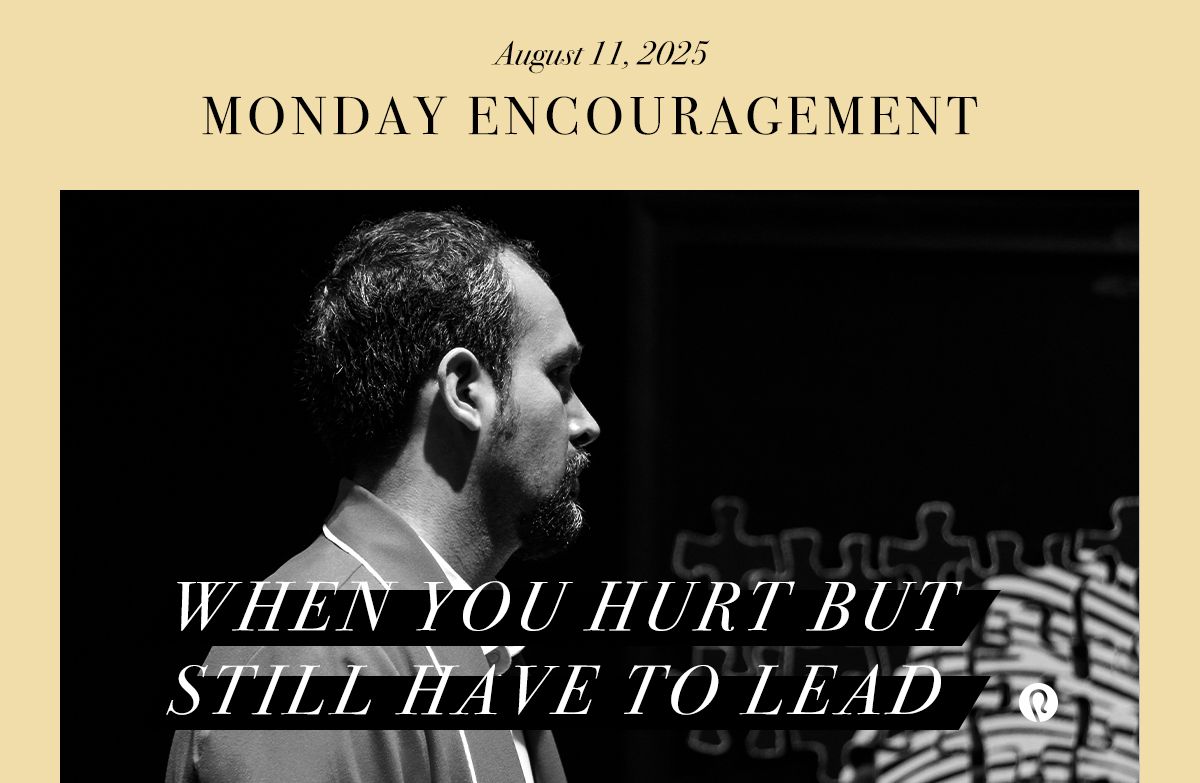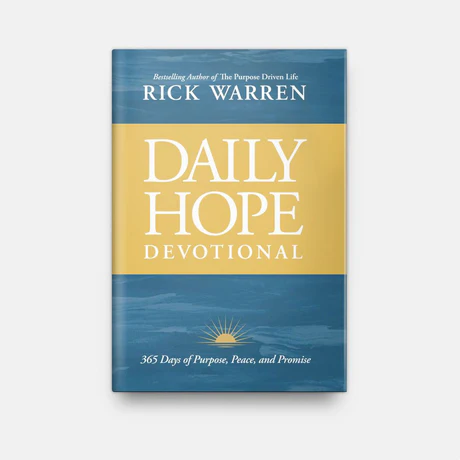
When You Hurt But Still Have to Lead
“Since Christ suffered and underwent pain, you must have the same attitude he did; you must be ready to suffer, too. For remember, when your body suffers, sin loses its power.” 1 Peter 4:1 (TLB)Pastor, let’s be honest: When you’re hurting, it’s hard to think about anyone else. That’s true of all of us—it’s human nature. When you’re in pain, everything in you wants comfort. You long for rest. You wish someone would just stop and care for you. And that’s completely normal.But as a pastor, you’re not just called to endure pain—you’re called to minister through it.Jesus models this for us on the cross. In his final, agonizing moments—while carrying the full weight of the world’s sin—Jesus looked around and saw others. He prayed for his executioners: “Father, forgive them. They don’t know what they’re doing” (Luke 23:34 GW). He gave assurance to a dying thief: “Today you will be with me in paradise” (Luke 23:43 GW). And he made sure his mother would be cared for.Even while suffering more than we can imagine, Jesus wasn’t consumed by himself. He noticed the hurting around him—and responded with love.Paul tells us to adopt the same attitude: “Let this mind be in you which was also in Christ Jesus” (Philippians 2:5 NKJV).That’s not easy. Especially when you're leading a church while carrying hidden pain of your own—grief, disappointment, anxiety, or spiritual exhaustion.But with God’s grace, you can lift your eyes. You can choose to see the pain of your people. You can comfort others, even as you wait for comfort yourself.And something happens when you do: Sin loses its grip. The self-centered pull of pain loosens. You become more like Jesus. And your suffering becomes sacred ground where healing begins—for you and for those you lead.So as you start this week, pastor, take heart. Jesus sees your pain. He’s using it. And through it, he’s shaping you into a shepherd who reflects his own heart.You’re not alone. You’re not forgotten. And your pain is not wasted.
When You Hurt But Still Have to Lead

Call Your Leaders to More
Pastor, one of the clearest signs your church is growing in maturity is this: The standards for leadership keep rising. As your people grow deeper in Christ, your expectations for leaders should grow with them. Every year, raise the bar of leadership commitment—and you'll raise the spiritual depth of your entire church.When Saddleback first began, our only requirement for serving in some ministries was that you had a pulse! But over time, we realized that raising the standard helped everyone. We strengthened expectations for lay pastors, musicians, and other ministry positions—and each time, the whole church took a step forward.A rising tide lifts all boats. When you elevate leadership commitment, you set the pace for your congregation.1. Focus on Your Leaders, Not the CrowdYou can't lead your church by catering to the least committed. Even the semi-committed can't set the tone. Your leaders set the example for everyone else. Raise their level of commitment first, and the rest of your church will follow.2. Ask Boldly for CommitmentScripture says, "You do not have because you do not ask God" (James 4:2 NIV). That principle applies to leadership too. If you don’t ask people for commitment, you won’t get it.Other organizations require serious commitment. If you've been a Little League parent, you know: snacks, rides, uniforms, victory parties—it takes a lot! Yet churches often ask for less.One of the most loving things you can do is help people choose their commitments wisely. Many believers are over-committed to causes that don’t really matter. Jesus warned us in Luke 8:14: “The seed that fell among thorns stands for those who hear, but as they go on their way they are choked by life's worries, riches and pleasures, and they do not mature" (NIV). Help your people make commitments that lead to maturity.3. Make Big Asks with Big VisionJesus never hesitated to ask for total commitment. He called grown adults to drop everything and follow him. In Luke 14:33, he said, "Those of you who do not give up everything you have cannot be my disciples” (NIV). That’s a bold invitation.People respond to vision, not need. Most stewardship campaigns fail because they highlight the church’s needs, not its mission. People want to be part of something significant. Cast a compelling vision, and people will gladly rise to the challenge.4. Be Specific about ExpectationsVague commitments lead to shallow results. Clarify what you’re asking of people. At Saddleback, we asked our members to make four specific commitments, each with a corresponding covenant:Membership CovenantMaturity CovenantMinistry CovenantMissions CovenantEach covenant outlined what was expected. Don’t just say, “Be committed to Christ.” Spell out what that means.5. Explain the Benefits of CommitmentGod never commands without attaching a promise. Remind your people of the blessings that come from obedience.Talk about how commitment changes lives:Personally: They grow spiritually and emotionallyFamily: Their home becomes more groundedChurch: They contribute to a stronger, healthier bodyCommunity: They live as salt and lightEternally: They store up treasures in heavenPeople have a deep desire to grow—you just need to help them see the value.6. Build on Commitment, Not toward ItDon’t wait for perfect commitment before involving people in ministry. Start with the willingness they have, then help them grow into deeper commitment.That’s how parenting works. Most couples don’t feel ready before the baby comes. But they grow into the role.You can also break big commitments into small steps. That’s the idea behind Saddleback’s CLASS system. Let people take baby steps—and celebrate each one.Pastor, your leadership sets the tone.If you raise the commitment of those closest to you, the ripple effect will impact your entire church. Don’t be afraid to call people to a higher standard. Jesus did—and he changed the world.
Call Your Leaders to More

What’s the Difference Between Leading and Managing?
If you want to know the temperature of your church, put the thermometer in your own mouth. That’s what my old ministry professor used to say—and he was right. You can’t take your church any farther than you’ve gone yourself. That’s why leadership matters so much in ministry.You’ve probably heard it said: Everything rises or falls on leadership. That’s never more true than in your church. I’ve seen churches in great locations that struggle, and churches in terrible locations that thrive. The difference is leadership. And, thankfully, you don’t have to have a charismatic personality to be a great leader.What makes a leader effective? Not charisma, but vision.Leadership Starts with VisionWhether you lead a whole church or a specific ministry area, your primary job is to keep the vision clear. You need to be able to answer this question: Why are we here? If you don’t know, you can’t lead.When I served as senior pastor at Saddleback, my job was to keep us focused on the original New Testament purpose of the church. That got harder the larger our church became. When we were small, people came because they were spiritually hungry—not for programs. But as we grew and added ministries, we began attracting more transfers from other churches. And every one of those transfers came with baggage.Often the first thing out of their mouths was, “At our old church, we did it like this . . .”I had to learn to graciously and repeatedly say: “We’re not trying to copy another church’s vision. We’re pursuing this vision.”So we communicated that vision over and over—in our new members class, our church newsletter, and just about every way we could. The “why” behind what we did was always front and center.The Difference Between Leading and ManagingSo what’s the difference between leading and managing?It comes down to this: Management is about analysis, problem-solving, and planning. Leadership is about vision and values—and communicating both.Most churches are over-managed and under-led. That leads to what I call “paralysis of analysis.”It’s like, “Ready . . . aim . . . aim . . . aim . . .” but they never fire.Don’t get me wrong. Churches need management, too. Without it, you get the opposite problem: “Ready . . . fire!” with no aiming at all.You need both. But if you, as the leader, don’t clarify the vision and values, no one else will.Why Vision MattersProverbs 29:18 says, “Where there is no vision, the people perish” (KJV). Some people dream big dreams but never turn them into anything actionable. Vision is a pragmatic dream—a dream you can implement. It’s specific. Nothing becomes dynamic until it becomes specific.When I look back on Saddleback’s first service, I’m still amazed at what God has done. What began with just a small group of people and a simple vision grew into a global movement.That’s the power of a God-given vision.Pastor, Here’s What to Do NextAsk God to clarify your vision.Repeat it often to your church.Lead with vision. Manage with wisdom. Do both.But never let management crowd out your leadership. Because your people can’t follow where you haven’t led.
What’s the Difference Between Leading and Managing?

How to Adapt to Lead a Growing Church
Pastor, before your church can grow to the next level, you need to understand the stage you're in now. Different stages of church growth require different leadership skills. You won’t lead a church of 400 the same way you lead a church of 40.There’s nothing wrong with that. In fact, it’s by God’s design. But it does mean you need to be willing to grow and change if you want your church to do the same.Here’s a simple framework I’ve used for decades. It identifies three types of churches, each with unique structures and leadership needs:1. Single-Cell Churches (under 200 people)In a single-cell church, one group of people make up the entire church. There are only a few ministry groups, and relationships are close. Everyone knows everyone else. This stage often feels like a family.At this level, the pastor operates like an owner/operator. You do everything: printing bulletins, unlocking the church, sweeping floors, and preaching. You're the entrepreneur keeping everything going.Many pastors love this stage because it feels personal and manageable. But if your church is going to grow beyond this, something has to change.2. Multiple-Cell Churches (200-300 people)In this stage, the church includes multiple groups: small groups, Sunday school classes, men's and women's ministries, and more. It’s no longer possible for the pastor to do everything.The pastor’s role must shift to manager/supervisor. You begin building a team. You train and empower others. Instead of doing all the ministry yourself, your role is to lead others who do ministry.This is where many churches get stuck. The transition from operator to manager is difficult. You must learn to delegate and trust others with key responsibilities.Your worship services also need to improve. In a small church, people overlook imperfections because it's like family. But once your church hits 300, people are attending for different reasons. They may not have personal connections yet, so they’re evaluating the church based on the worship experience, teaching, and excellence.3. Multiple-Congregation Churches (400+ people)Larger churches function as a congregation of congregations. Ministries—like children’s, men’s, and women’s ministries—become self-contained congregations within the church, each with their own leaders and programs.At this level, the pastor must become an executive leader. This doesn’t mean controlling everything. In fact, you need to let go of many day-to-day decisions. The executive pastor and leadership team handle the details.Your primary roles become:Setting the visionPreaching and teachingMaking high-level decisionsAs the church grows, the pulpit becomes the most powerful tool to set direction. People follow the vision you cast from the stage.You Can’t Be Great at Every Stage—and That’s OkayIt’s rare to find a pastor who is naturally skilled at all three of these stages. Most leaders thrive in one. That’s why it’s so important to build a team that complements your gifts.Personally, I struggled in the manager stage. I was great doing it all myself or stepping back to lead at a high level—but not at managing. Saddleback got stuck for a time until I learned to surround myself with people who were strong supervisors and administrators.Wherever you are now, I want to encourage you: Stick to the vision God gave you. You might be hauling gear in and out of your garage every Sunday. I’ve been there too. Don’t give up. Trust God to grow you as he grows your church.How to Prepare for the Next StageIn a single-cell church, growth comes by adding new cells. Start more groups, more classes, even more services. Multiply your church’s connection points.In a multiple-cell church, improve the worship experience. Make it excellent and relevant. Recognize that people are no longer coming primarily because of friendships—they’re coming to see if your church is worth their time and trust.In a multiple-congregation church, focus on staff management. Delegate well. Develop leaders. Protect your time so you can lead with clarity and preach with power.As your church grows, your leadership must grow too.You don’t need to be everything. You just need to be willing to change. Let God shape you into the kind of leader your church needs at each stage.God has placed you in your church for a reason. Keep growing, and keep leading with vision and humility.
How to Adapt to Lead a Growing Church








